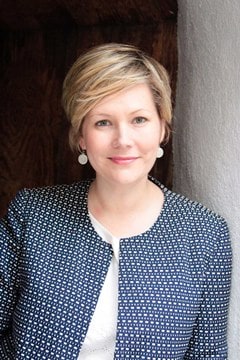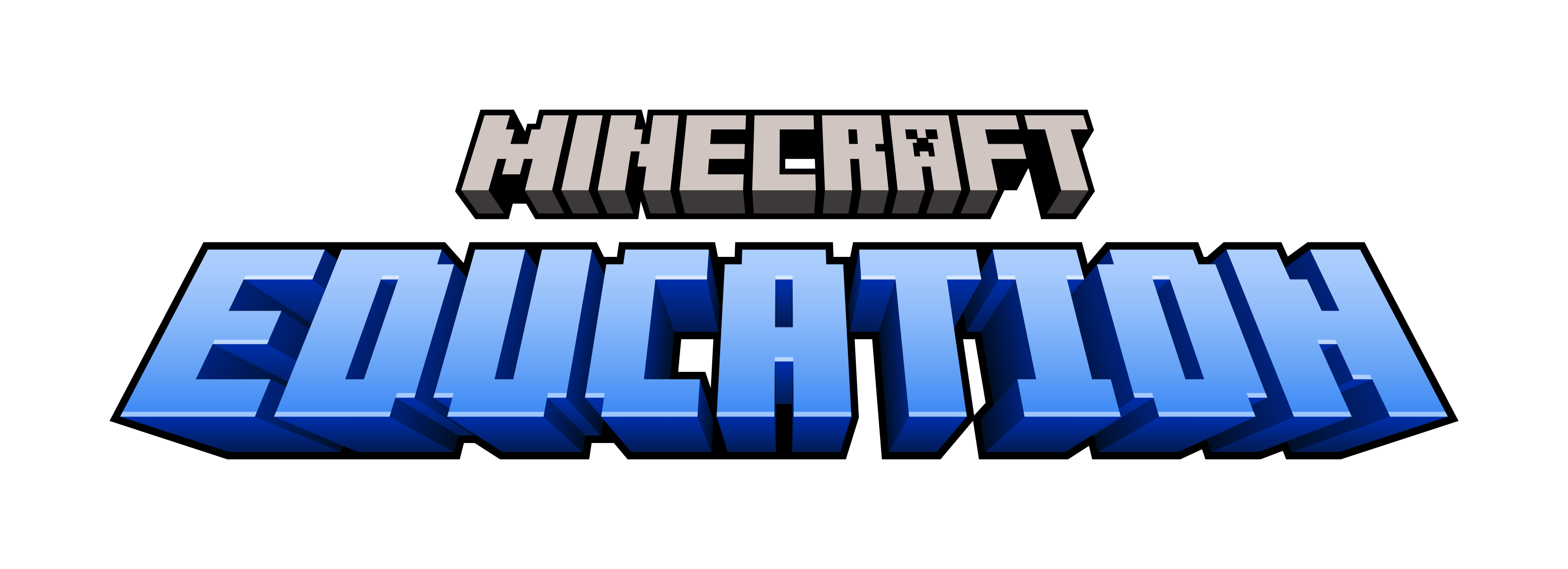G4C reflection from @linlouj and Anders: Co-Designing Learning Experiences with Students
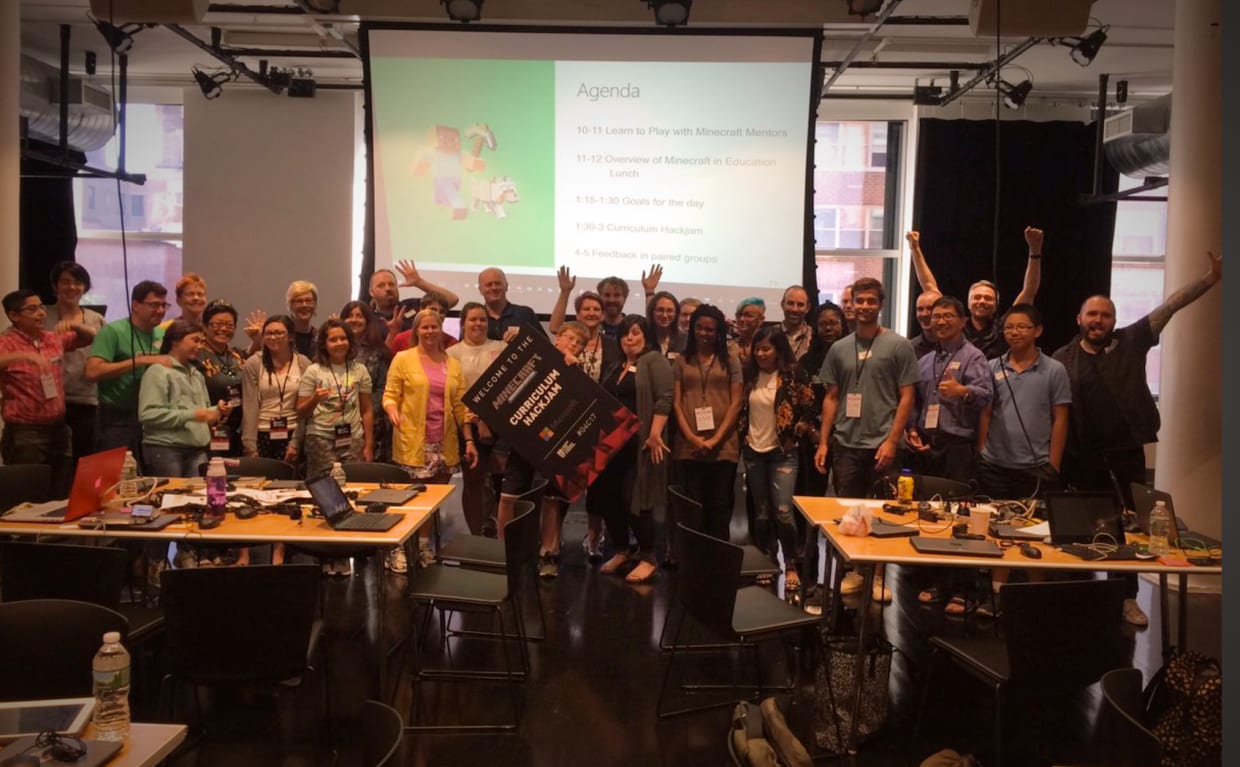
Minecraft Edu Hackjam was a pre-event at the 2017 Games 4 Change Conference. According to advance material, the goal of the hackjam was to “convene 50 educators, designers, and Minecraft mentors to make subject-area curriculum relevant, immersive, and impactful for all students. Based on each group’s strength and interest, participants will turn their expertise into Minecraft: Education Edition lesson plans to be used by educators around the world.”
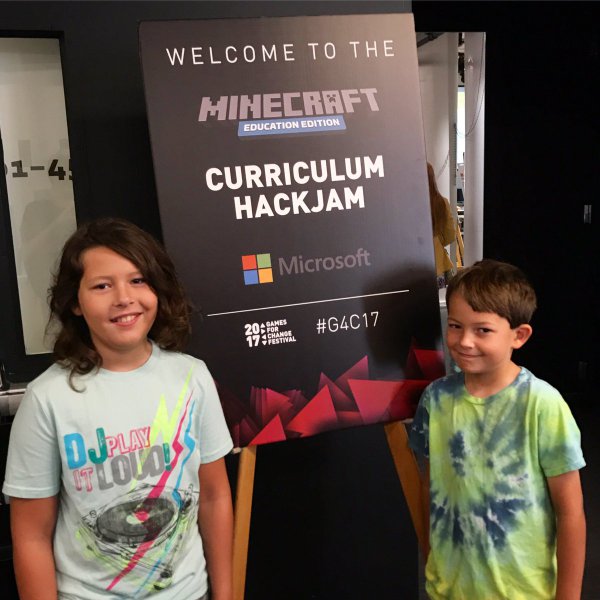 One of the coolest things about participating in the Minecraft Edu Curriculum Hackjam was the opportunity to co-design learning experiences with young people. I’ve had the opportunity to lead a lot of workshops with and for teachers; many times I suggest bringing students into the mix, but this idea rarely gets traction. So, I was super happy that my friend, Meenoo Rami, not only invited me to this event, but encouraged me to bring young people I knew who were avid Minecraft players. Luckily, I just happen to live with two such young people: Anders (age 12) and Willem (age 9) have both played Minecraft for a number of years. And, keeping with the spirit of collaboration, Anders is joining me in co-authoring this blog post. You can read his thoughts below. We began the hackjam with a brief overview of what Minecraft is and why teachers might want to use it. Meenoo emphasized that Minecraft was one tool in a teacher’s toolbox. We then had the chance to start playing around in the Minecraft Education Edition (which has some different features than vanilla Minecraft). As a clueless novice Minecraft player, I was grateful for the guided tutorial that taught me how to move forward, backward, and side-to-side. I also learned how to break blocks, stack blocks, swim, and craft. Even though it sounds simple, I needed help with a few skills (like how to pull down levers). If you think that young people are being dumbed down by video games, I encourage you to go and try to learn a new game. The struggle is real. Alternatively, read Gee’s book, What Video Games Can Teach Us About Learning and Literacy.
One of the coolest things about participating in the Minecraft Edu Curriculum Hackjam was the opportunity to co-design learning experiences with young people. I’ve had the opportunity to lead a lot of workshops with and for teachers; many times I suggest bringing students into the mix, but this idea rarely gets traction. So, I was super happy that my friend, Meenoo Rami, not only invited me to this event, but encouraged me to bring young people I knew who were avid Minecraft players. Luckily, I just happen to live with two such young people: Anders (age 12) and Willem (age 9) have both played Minecraft for a number of years. And, keeping with the spirit of collaboration, Anders is joining me in co-authoring this blog post. You can read his thoughts below. We began the hackjam with a brief overview of what Minecraft is and why teachers might want to use it. Meenoo emphasized that Minecraft was one tool in a teacher’s toolbox. We then had the chance to start playing around in the Minecraft Education Edition (which has some different features than vanilla Minecraft). As a clueless novice Minecraft player, I was grateful for the guided tutorial that taught me how to move forward, backward, and side-to-side. I also learned how to break blocks, stack blocks, swim, and craft. Even though it sounds simple, I needed help with a few skills (like how to pull down levers). If you think that young people are being dumbed down by video games, I encourage you to go and try to learn a new game. The struggle is real. Alternatively, read Gee’s book, What Video Games Can Teach Us About Learning and Literacy.
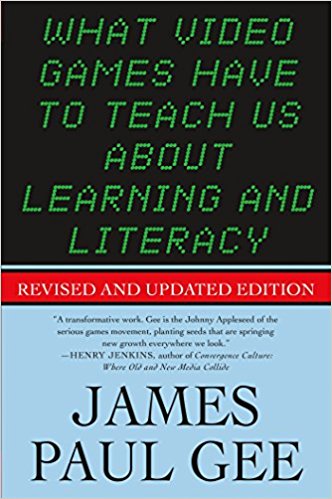 After we completed the tutorial, Meenoo asked us to divide into groups based on our content expertise and then presented us with an open-ended challenge: Create a lesson plan that utilizes the unique affordances of Minecraft: Education Edition to teach a common topic, standard, or lesson in your classroom. My group quickly determined that we wanted to create a lesson that any teacher with limited Minecraft expertise could use. We also wanted to be sure that the lesson we created directly met a variety of English and History standards. We decided to choose a topic that is sometimes difficult to get students excited about: the U.S. Constitution. Our group had a great mix of Minecraft experts (including Anders, and a preservice teacher, Chris) and experienced teachers. We quickly began brainstorming ideas and came up with the idea to create a simulation in Minecraft where students could experience what it would be like to be in a society without rules. We called our lesson “Why Do We Need Rules?: Introducing the U.S. Constitution through Minecraft.” The “hook” of our lesson included a mini game. Students are divided into five teams. The goal of the game is to find as many diamonds as possible in Minecraft. Students have 10 minutes to get those diamonds by any means. The idea is that students will quickly learn why rules can be helpful. Chris and Anders created a video walk through of the mini game here. I’d never created curriculum with young people before, so I wasn’t sure how the process would play out. In retrospect, I was surprised by how easy it was for us all to collaborate. The young people helped us make connections and think through how to connect academic content to Minecraft in
After we completed the tutorial, Meenoo asked us to divide into groups based on our content expertise and then presented us with an open-ended challenge: Create a lesson plan that utilizes the unique affordances of Minecraft: Education Edition to teach a common topic, standard, or lesson in your classroom. My group quickly determined that we wanted to create a lesson that any teacher with limited Minecraft expertise could use. We also wanted to be sure that the lesson we created directly met a variety of English and History standards. We decided to choose a topic that is sometimes difficult to get students excited about: the U.S. Constitution. Our group had a great mix of Minecraft experts (including Anders, and a preservice teacher, Chris) and experienced teachers. We quickly began brainstorming ideas and came up with the idea to create a simulation in Minecraft where students could experience what it would be like to be in a society without rules. We called our lesson “Why Do We Need Rules?: Introducing the U.S. Constitution through Minecraft.” The “hook” of our lesson included a mini game. Students are divided into five teams. The goal of the game is to find as many diamonds as possible in Minecraft. Students have 10 minutes to get those diamonds by any means. The idea is that students will quickly learn why rules can be helpful. Chris and Anders created a video walk through of the mini game here. I’d never created curriculum with young people before, so I wasn’t sure how the process would play out. In retrospect, I was surprised by how easy it was for us all to collaborate. The young people helped us make connections and think through how to connect academic content to Minecraft in
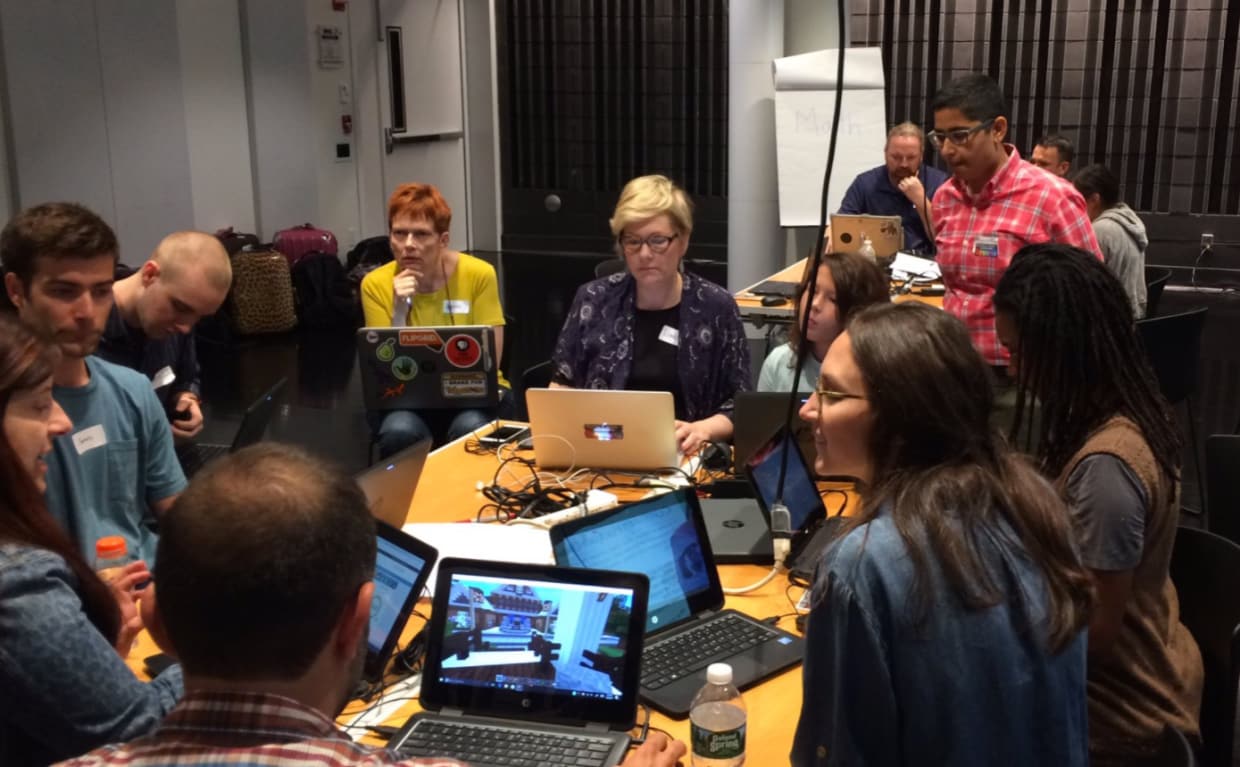 ways that I never would have thought of. Having youth at the table also created opportunities to engage in rapid prototyping of our lesson plan activities. For example, we asked Anders “what would happen if we just let people roam around the world we created? Would chaos ensue?” His answer “oh yeah!” Anders was able to use his knowledge and expertise in Minecraft to help us anticipate what might work and what might not work in the lesson really quickly. Often as teachers, we plan what we think are beautiful lessons, but don’t often get feedback from students until after we have taught the lesson. The Hackjam used a completely different process. As Nikomo, a teacher in our group said, “There’s no way we could have created this lesson without Anders.” Even though we spent about 3 hours designing the lesson plan, it didn’t feel like work; it felt like play. The joy of creating something together with young people was really fun, and it’s something I hope that I get to do more of in the future. Here’s Anders take on the day’s events: When I first learned about this program I thought it would be a fun way to associate Minecraft with education and I was very excited for the future with that. I wasn’t sure if I would stay [at the hackjam] the entire time because I didn’t know what to expect. Before we entered the workshop people were not shy to say hello and interact and we already had many developing friendships. We went into the classroom and first learned what Minecraft was in summary form and then Meenoo said that she sees Minecraft as one of the tools in a teacher’s toolbox and can’t be used to solve every problem. Next we did a tutorial on Minecraft Education Edition, which has some features taken out and some new features to help teachers to be able to control the students. The tutorial teaches players how to use the basic functions of Minecraft in a step-by-step process that gets more advanced as you move along. The tutorial would be helpful for a novice player but there are some parts where the road splits and it may be confusing which way to go, otherwise stupendous. I thought it was fun to work with teachers and get to know what’s happening in the teaching world. It was cool to work together and to create something new with teachers, and to get students excited about the U.S. Constitution. Lindy Johnson is an Assistant Professor of English Education and Co-Director for the Center for Innovation in Learning Design at William and Mary. She earned an M.Ed. from the University of Massachusetts, Boston, and a Ph.D. in Language and Literacy Education from The University of Georgia. Prior to pursuing her doctorate, I taught high school English in Boston Public Schools. My research interests include new and digital literacies, teacher education, design based research, and critical discourse analysis.
ways that I never would have thought of. Having youth at the table also created opportunities to engage in rapid prototyping of our lesson plan activities. For example, we asked Anders “what would happen if we just let people roam around the world we created? Would chaos ensue?” His answer “oh yeah!” Anders was able to use his knowledge and expertise in Minecraft to help us anticipate what might work and what might not work in the lesson really quickly. Often as teachers, we plan what we think are beautiful lessons, but don’t often get feedback from students until after we have taught the lesson. The Hackjam used a completely different process. As Nikomo, a teacher in our group said, “There’s no way we could have created this lesson without Anders.” Even though we spent about 3 hours designing the lesson plan, it didn’t feel like work; it felt like play. The joy of creating something together with young people was really fun, and it’s something I hope that I get to do more of in the future. Here’s Anders take on the day’s events: When I first learned about this program I thought it would be a fun way to associate Minecraft with education and I was very excited for the future with that. I wasn’t sure if I would stay [at the hackjam] the entire time because I didn’t know what to expect. Before we entered the workshop people were not shy to say hello and interact and we already had many developing friendships. We went into the classroom and first learned what Minecraft was in summary form and then Meenoo said that she sees Minecraft as one of the tools in a teacher’s toolbox and can’t be used to solve every problem. Next we did a tutorial on Minecraft Education Edition, which has some features taken out and some new features to help teachers to be able to control the students. The tutorial teaches players how to use the basic functions of Minecraft in a step-by-step process that gets more advanced as you move along. The tutorial would be helpful for a novice player but there are some parts where the road splits and it may be confusing which way to go, otherwise stupendous. I thought it was fun to work with teachers and get to know what’s happening in the teaching world. It was cool to work together and to create something new with teachers, and to get students excited about the U.S. Constitution. Lindy Johnson is an Assistant Professor of English Education and Co-Director for the Center for Innovation in Learning Design at William and Mary. She earned an M.Ed. from the University of Massachusetts, Boston, and a Ph.D. in Language and Literacy Education from The University of Georgia. Prior to pursuing her doctorate, I taught high school English in Boston Public Schools. My research interests include new and digital literacies, teacher education, design based research, and critical discourse analysis.
